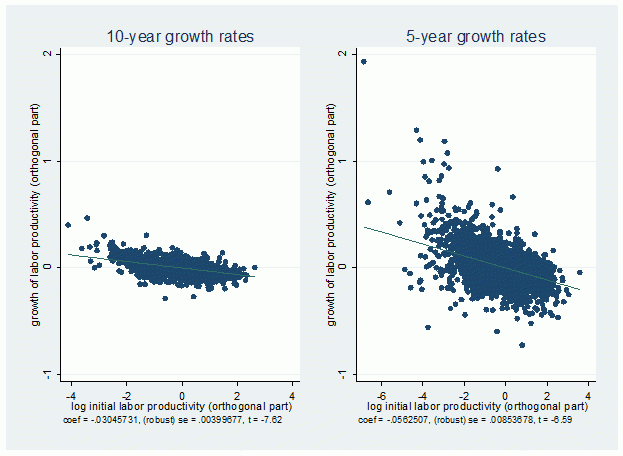Poor countries have access to world markets, off-the-shelf technologies developed by others, and rich countries’ savings. So in principle, they should develop rapidly – more rapidly than advanced economies, which are already at the technological frontier. Yet the historical record belies this expectation. Economic convergence depends in practice on a whole host of policy, institutional, and geographic determinants, the nature of which remains vigorously debated (Acemoglu 2009).
Yet it turns out that there is an important segment of developing countries’ economies that behaves precisely as simple theories predict. As I document in a recent paper (Rodrik 2011a), labour productivity in (formal) manufacturing displays a clear tendency towards unconditional convergence. Manufacturing industries that start further away from the frontier experience faster productivity growth, regardless of geographic location and country-level influences.
I estimate a coefficient of unconditional convergence that is statistically highly significant and quite large, at 3.0-5.6% per year depending on the estimation horizon. These estimates imply that industries that are, say, a quarter of the way to the technology frontier will experience labour productivity growth at a rate of 4.1-7.8 percentage points per annum. My data come from UNIDO’s industrial statistics database, which is derived largely from industrial surveys (UNIDO 2011). Since microenterprises and informal firms are often excluded from such surveys, these results should be as viewed as applying to the organised, formal parts of manufacturing.
My central result is illustrated in Figure 1. The scatter plot shows the partial relationship between the growth of labour productivity and its initial level controlling for a number of fixed effects. Each dot on the scatter plot represents a four-digit industry in a specific country. (Illustrative industries: macaroni, noodles and similar products, pesticides and other agrochemical products, agricultural and forestry machinery.) The two panels depict growth rates over a decade (left-hand side) and five years (right-hand side), respectively. Each country is represented over a single time horizon, with the most recent ten- or five-year period since 1990 for which it has data. Industry, decade, and industry × decade dummies are included in the regressions used to generate both plots.
Figure 1. Unconditional convergence in four-digit industries
Since these plots do not control for country-level determinants, they represent a test of unconditional convergence. (The need for period and industry fixed effects is motivated in Rodrik 2011a.) The negative and highly significant slope is unmistakable, illustrating the central result that manufacturing exhibits a strong tendency for unconditional convergence. Industries that start at lower levels of labour productivity experience more rapid growth in labour productivity. When controls for country-specific determinant such as policies or institutions are included convergence is even more rapid. But what is striking in the figure is the evident strength of convergence in the data even in the absence of such controls.
To my knowledge, this is the first demonstration of unconditional convergence in industry for a wide range of countries and for detailed manufacturing industries. There does not seem to be any work that has looked at highly disaggregated data for manufacturing or at the manufacturing experience of countries beyond OECD and US states (Bernard and Jones 1996a and 1996b; see also Sørensen 2001). However, in unpublished work, Hwang (2007, ch 3) has documented that there is a tendency for unconditional convergence in export unit values in highly disaggregated product lines. Once a country begins to export something, it travels up the value chain in that product regardless of domestic policies or institutions. Hwang shows that the lower the average unit values of a country’s manufactured exports, the faster the country’s subsequent growth, unconditionally. My results differ from Hwang’s in that they focus on output rather than exports, and directly on productivity (rather than unit values). Convergence seems to kick in manufacturing regardless of whether production is exported.
Unconditional convergence seems to characterise the vast majority of the (formal) manufacturing industries included in my data. But the estimated convergence coefficient is not uniform. Convergence appears to be least rapid in textiles and clothing and most rapid in machinery and equipment, with transport equipment and iron, steel and metal products somewhere in between. So there is a hierarchy within manufacturing that fits well with intuition. Even within manufacturing some of the ‘escalators’ move up more quickly than others.
How do we reconcile unconditional convergence in manufacturing with its absence for economies as a whole? In Rodrik (2011a) I develop a decomposition to identify the factors that weaken the forces of convergence as we aggregate up from individual manufacturing industries. The exercise highlights the role of structural factors, in particular the slow (and sometimes perverse) movement of resources across economic activities with different convergence characteristics.
The trouble from a convergence standpoint is that economic activities that are good at absorbing advanced technologies are not necessarily also good at absorbing labour. As a result, too large a fraction of an economy’s resources can get stuck in the ‘wrong’ sectors – those that are not on the escalator up. When firms that are part of international production networks or that otherwise benefit from globalisation employ little labour, the gains remain limited. Even worse, intersectoral labour flows can be perverse with the consequence that convergence within the ‘advanced’ sectors is accompanied by divergence on the part of the economy as a whole. The analyses in Rodrik (2011a) and McMillan and Rodrik (2011) illustrate these outcomes using the experience of specific Latin American and African countries with such perverse patterns.
Though these findings are new, it is perhaps not surprising that manufacturing industries should exhibit unconditional convergence, at quite a rapid pace too. These industries produce tradable goods and can be rapidly integrated into global production networks, facilitating technology transfer and absorption. Even when they produce just for the home market, they operate under competitive threat from efficient suppliers from abroad, requiring that they upgrade their operations and remain efficient. Traditional agriculture, many nontradable services, and especially informal economic activities do not share these characteristics.
These results offer new insight on the determinants of economic growth and convergence across countries. They suggest that lack of convergence is due not so much to economy-wide misgovernance or endogenous technological change, but to specific circumstances that influence the speed of structural reallocation from nonconvergence to convergence activities. The policies that matter are those that bear directly on this reallocation. As discussed in Rodrik (2011b), what high-growth countries typically have in common is their ability to deploy policies that compensate for the market and government failures that block growth-enhancing structural transformation. Countries that manage to affect the requisite structural change grow rapidly while those that fail don’t.
References
Acemoglu, Daron (2009) “Modern Economic Growth”, VoxEU.org, 27 February.
Bernard, Andrew, and Charles Jones (1996a), “Productivity and Convergence across U.S. tates and Industries,” Empirical Economics, March 1996, Vol. 21, pp. 113-135.
Bernard, Andrew, and Charles Jones (1996b), “Comparing Apples to Oranges: Productivity Convergence and Measurement Across Industries and Countries,” American Economic Review, December 1996, Vol. 86, pp. 1216-1238.
Hwang, Jason J. (2007), “Patterns of Specialization and Economic Growth,” unpublished PhD dissertation, Economics Department, Harvard University.
McMillan, Margaret, and Dani Rodrik (2011), “Globalization, Structural Change, and Productivity Growth,” NBER Working Paper 17143.
Rodrik, Dani (2011a), “Unconditional Convergence,” CEPR Discussion Paper 8631, November.
Rodrik, Dani (2011b), “The Future of Economic Convergence,” NBER Working Paper 17400, September.
Sørensen, Anders (2001), “Comparing Apples and Oranges: Productivity Convergence and Measurement Across Industries and Countries: Comment,” American Economic Review, 91(4): 1160-1167.
UNIDO (2011), “INDSTAT4 Industrial Statistics Database - 2011 edition”. United Nations Industrial Development Organization.




